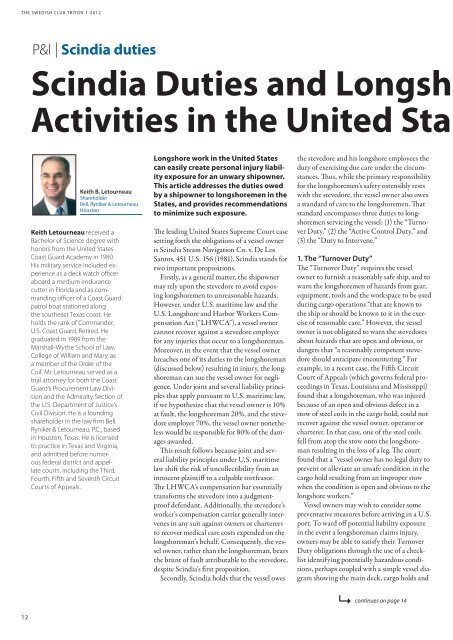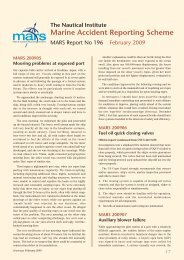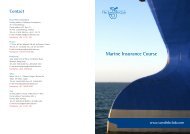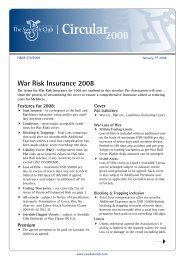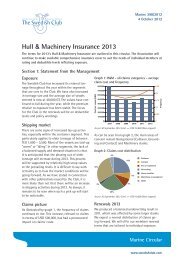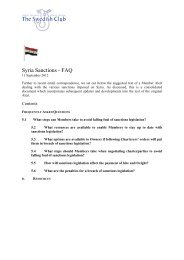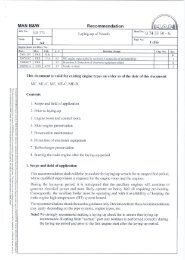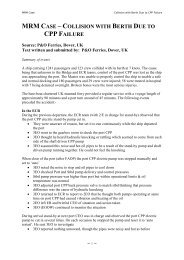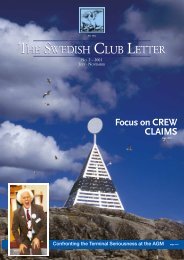TSC Triton no. 1 2012 - The Swedish Club
TSC Triton no. 1 2012 - The Swedish Club
TSC Triton no. 1 2012 - The Swedish Club
- No tags were found...
Create successful ePaper yourself
Turn your PDF publications into a flip-book with our unique Google optimized e-Paper software.
THE SWEDISH CLUB TRITON 1-<strong>2012</strong>P&I | Scindia dutiesScindia Duties and LongshActivities in the United StaKeith B. LetourneauShareholderBell, Ryniker & LetourneauHoustonKeith Letourneau received aBachelor of Science degree withho<strong>no</strong>rs from the United StatesCoast Guard Academy in 1980.His military service included experienceas a deck watch officeraboard a medium endurancecutter in Florida and as commandingofficer of a Coast Guardpatrol boat stationed alongthe southeast Texas coast. Heholds the rank of Commander,U.S. Coast Guard, Retired. Hegraduated in 1989 from theMarshall-Wythe School of Law,College of William and Mary, asa member of the Order of theCoif. Mr. Letourneau served as atrial attorney for both the CoastGuard’s Procurement Law Divisionand the Admiralty Section ofthe U.S. Department of Justice’sCivil Division. He is a foundingshareholder in the law firm Bell,Ryniker & Letourneau, P.C., basedin Houston, Texas. He is licensedto practice in Texas and Virginia,and admitted before numerousfederal district and appellatecourts, including the Third,Fourth, Fifth and Seventh CircuitCourts of Appeals.Longshore work in the United Statescan easily create personal injury liabilityexposure for an unwary shipowner.This article addresses the duties owedby a shipowner to longshoremen in theStates, and provides recommendationsto minimize such exposure.<strong>The</strong> leading United States Supreme Court casesetting forth the obligations of a vessel owneris Scindia Steam Navigation Co. v. De LosSantos, 451 U.S. 156 (1981). Scindia stands fortwo important propositions.Firstly, as a general matter, the shipownermay rely upon the stevedore to avoid exposinglongshoremen to unreasonable hazards.However, under U.S. maritime law and theU.S. Longshore and Harbor Workers CompensationAct (“LHWCA”), a vessel ownercan<strong>no</strong>t recover against a stevedore employerfor any injuries that occur to a longshoreman.Moreover, in the event that the vessel ownerbreaches one of its duties to the longshoreman(discussed below) resulting in injury, the longshoremancan sue the vessel owner for negligence.Under joint and several liability principlesthat apply pursuant to U.S. maritime law,if we hypothesize that the vessel owner is 10%at fault, the longshoreman 20%, and the stevedoreemployer 70%, the vessel owner <strong>no</strong>nethelesswould be responsible for 80% of the damagesawarded.This result follows because joint and severalliability principles under U.S. maritimelaw shift the risk of uncollectibility from anin<strong>no</strong>cent plaintiff to a culpable tortfeasor.<strong>The</strong> LHWCA’s compensation bar essentiallytransforms the stevedore into a judgmentproofdefendant. Additionally, the stevedore’sworker’s compensation carrier generally intervenesin any suit against owners or charterersto recover medical care costs expended on thelongshoreman’s behalf. Consequently, the vesselowner, rather than the longshoreman, bearsthe brunt of fault attributable to the stevedore,despite Scindia’s first proposition.Secondly, Scindia holds that the vessel owesthe stevedore and his longshore employees theduty of exercising due care under the circumstances.Thus, while the primary responsibilityfor the longshoremen’s safety ostensibly restswith the stevedore, the vessel owner also owesa standard of care to the longshoremen. Thatstandard encompasses three duties to longshoremenservicing the vessel: (1) the “Tur<strong>no</strong>verDuty,” (2) the “Active Control Duty,” and(3) the “Duty to Intervene.”1. <strong>The</strong> “Tur<strong>no</strong>ver Duty”<strong>The</strong> “Tur<strong>no</strong>ver Duty” requires the vesselowner to furnish a reasonably safe ship, and towarn the longshoremen of hazards from gear,equipment, tools and the workspace to be usedduring cargo operations “that are k<strong>no</strong>wn tothe ship or should be k<strong>no</strong>wn to it in the exerciseof reasonable care.” However, the vesselowner is <strong>no</strong>t obligated to warn the stevedoresabout hazards that are open and obvious, ordangers that “a reasonably competent stevedoreshould anticipate encountering.” Forexample, in a recent case, the Fifth CircuitCourt of Appeals (which governs federal proceedingsin Texas, Louisiana and Mississippi)found that a longshoreman, who was injuredbecause of an open and obvious defect in astow of steel coils in the cargo hold, could <strong>no</strong>trecover against the vessel owner, operator orcharterer. In that case, one of the steel coilsfell from atop the stow onto the longshoremanresulting in the loss of a leg. <strong>The</strong> courtfound that a “vessel owner has <strong>no</strong> legal duty toprevent or alleviate an unsafe condition in thecargo hold resulting from an improper stowwhen the condition is open and obvious to thelongshore workers.”Vessel owners may wish to consider somepreventative measures before arriving in a U.S.port. To ward off potential liability exposurein the event a longshoreman claims injury,owners may be able to satisfy their Tur<strong>no</strong>verDuty obligations through the use of a checklistidentifying potentially hazardous conditions,perhaps coupled with a simple vessel diagramshowing the main deck, cargo holds and129continueson page 14


